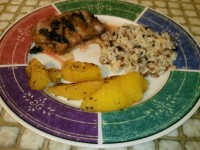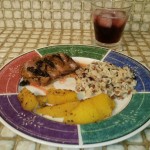So after reading Hank Shaw’s new cookbook and attending the duck-centric dinner at Range, ON TOP OF ordering duck two or three times in recent memory from my local Thai delivery joint, well, I was hellbent on preparing duck at home. The CGP and I have previously grilled whole ducks on the Big Green Egg, but I really wanted to try to cook duck breast on the stovetop, a la PBS and Hubert Keller. Okay, maybe not quite THAT lofty. But I definitely had duck on the brain.
Hank makes a case for cooking duck parts separately. The breast is best served seared and medium-rare, like a well-aged steak. The legs, cooked low and slow in their own fat (confit), are analogous to pulled pork. In my experience, it is next to impossible to roast a whole fowl and get a rare breast and well-done legs. So while I was eye-balling the whole frozen ducks at my grocer, I just wasn’t in the mood to thaw and break them down. I wanted CRISPY skin and I didn’t want to work too hard for it (I have my off days, too), so I went the easy route — boneless, skin-on breasts from the freezer case. The 14oz package was just the right portion for the pair of us, and it was a much more approachable quantity of fowl.
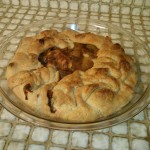
Sunday nights are our unofficial “Date Night” (Wednesdays being the official one). So I did want to do justice to the duck in terms of sides and beverage. I chose to make a wild-rice pilaf tossed with toasted pecans and dried currants and roasted off an acorn squash in the oven. I made a sangria and an apple pie for dessert. Definitely date-night worthy 
Duck breast isn’t any harder to cook than a steak. You need a a sharp knife, a heavy-bottomed skillet, and some salt and pepper. So this post isn’t so much a “recipe” — but a technique.
Prep:
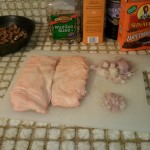 About 45 minutes before you throw your duck in the pan (that means about an hour before you want to eat), pull your thawed duck breast out of the fridge. If the two breast lobes are still attached — slice through the joining fat/skin and separate into two. Pat the both sides of the duck dry with a paper towel and sprinkle both fat side and meat side liberally with kosher salt. Let rest on a cutting board while you carry on (this is when I finished the squash and made my pilaf). After 40 minutes or so, use paper towels to thoroughly dry your duck and cutting board. Use a VERY sharp knife to cut a 1/2″ cross-hatch into the fat, being careful not to cut into the flesh. Use your fingers to gently spread the cuts to see that you are not accidentally butchering the flesh. Season the fat side with a generous amount of freshly-ground pepper, using your hands to press the pepper into the flesh. Smear a teaspoon or so of fat in the bottom of your cold pan. I used bacon fat, but previously rendered duck fat (lucky you!) or olive oil would work as well.
About 45 minutes before you throw your duck in the pan (that means about an hour before you want to eat), pull your thawed duck breast out of the fridge. If the two breast lobes are still attached — slice through the joining fat/skin and separate into two. Pat the both sides of the duck dry with a paper towel and sprinkle both fat side and meat side liberally with kosher salt. Let rest on a cutting board while you carry on (this is when I finished the squash and made my pilaf). After 40 minutes or so, use paper towels to thoroughly dry your duck and cutting board. Use a VERY sharp knife to cut a 1/2″ cross-hatch into the fat, being careful not to cut into the flesh. Use your fingers to gently spread the cuts to see that you are not accidentally butchering the flesh. Season the fat side with a generous amount of freshly-ground pepper, using your hands to press the pepper into the flesh. Smear a teaspoon or so of fat in the bottom of your cold pan. I used bacon fat, but previously rendered duck fat (lucky you!) or olive oil would work as well.
Cook:
Place the breasts fat-side down into the cold pan, making sure to press them down for maximium surface contact. Turn your pan to medium and let it all start to heat up. The fat will start to render and it will sound like bacon frying. Keep the temperature moderate — we want to render off fat without blackening the poor thing! Turn it down if it starts to sizzle too vigorously (sorry — that’s an instinctive thing!). It’s going to take at least 8 to 10 minutes, depending on fat your bird was. I will move the breasts around a little, just to make sure they don’t stick, but you pretty much leave them alone. When the skin is golden and crispy and most of the fat seems to have rendered, carefully flip them over. I say careful, because you could have 1/4″ to 1/2″ of happy bubbly fat in that pan by now. You are going to cook them just 3 or 4 minutes on the other side — just enough to brown the meat side. At Hank’s suggestion, I use my tongs to turn the pieces on each of their sides for just 20 or 30 seconds to “sear” the sides too.
Rest:
Remove to a clean cutting board and loosely tent with aluminum foil for 5 – 8 minutes while you make the pan sauce.
Pan Sauce:
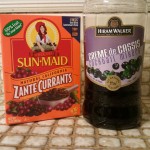 Carefully pour the accumulated liquid fat into a heat-proof container, leaving just a tablespoon or two behind in the pan. Put the pan back on the stove on medium. Toss in a tablespoon or so of finely chopped shallot. Stir that around until most of the oil is absorbed and they start to soften. Deglaze the pan with a tablespoon or three of chicken broth (duck broth if you’ve got it of course). Swirl around scraping up the dark bits (fond) and let some of it evaporate. Add 1 tablespoon of creme de cassis (currant liqueur) and a tablespoon of dried currants (I actually set the currants to soak in the liqueur about the same time I pulled the duck breasts out of the fridge). Swirl around and let it cook down a bit. Turn off the heat and add a teaspoon or two of softened butter, swirling to incorporate.
Carefully pour the accumulated liquid fat into a heat-proof container, leaving just a tablespoon or two behind in the pan. Put the pan back on the stove on medium. Toss in a tablespoon or so of finely chopped shallot. Stir that around until most of the oil is absorbed and they start to soften. Deglaze the pan with a tablespoon or three of chicken broth (duck broth if you’ve got it of course). Swirl around scraping up the dark bits (fond) and let some of it evaporate. Add 1 tablespoon of creme de cassis (currant liqueur) and a tablespoon of dried currants (I actually set the currants to soak in the liqueur about the same time I pulled the duck breasts out of the fridge). Swirl around and let it cook down a bit. Turn off the heat and add a teaspoon or two of softened butter, swirling to incorporate.
Serve:
Whirl around to the cutting board and slice your breasts across the grain, place on a plate, and spoon some of the pan sauce across the artfully arranged slices. Eat. Moan. Eat some more.

